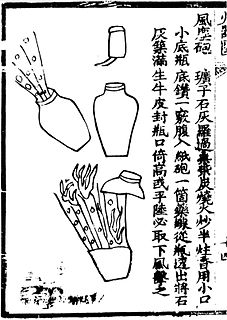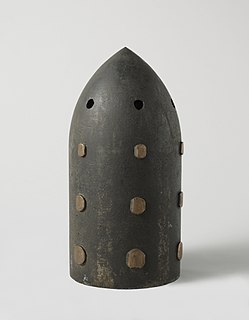
Trinitrotoluene more commonly known as TNT, or more specifically 2,4,6-trinitrotoluene, is a chemical compound with the formula C6H2(NO2)3CH3. This yellow solid is occasionally used as a reagent in chemical synthesis, but it is best known as an explosive material with convenient handling properties. The explosive yield of TNT is considered to be the standard comparative convention of bombs and asteroid impacts. In chemistry, TNT is used to generate charge transfer salts.

A bomb is an explosive weapon that uses the exothermic reaction of an explosive material to provide an extremely sudden and violent release of energy. Detonations inflict damage principally through ground- and atmosphere-transmitted mechanical stress, the impact and penetration of pressure-driven projectiles, pressure damage, and explosion-generated effects. Bombs have been utilized since the 11th century starting in East Asia.

2,4,6-Trinitrophenylmethylnitramine commonly referred to as tetryl (C7H5N5O8) is an explosive compound used to make detonators and explosive booster charges.

Picric acid is an organic compound with the formula (O2N)3C6H2OH. Its IUPAC name is 2,4,6-trinitrophenol (TNP). The name "picric" comes from the Greek word πικρός (pikros), meaning "bitter", due to its bitter taste. It is one of the most acidic phenols. Like other strongly nitrated organic compounds, picric acid is an explosive, which is its primary use. It has also been used as medicine (antiseptic, burn treatments) and as a dye.

Armor-piercing ammunition is a type of projectile designed to penetrate either body armor or vehicle armor.
An explosive booster is a sensitive explosive charge that acts as a bridge between a conventional detonator and a low-sensitivity explosive such as TNT. By itself, the initiating detonator would not deliver sufficient energy to set off the low-sensitivity charge. However, it detonates the primary charge, which then delivers an explosive shockwave that is sufficient to detonate the secondary, main, high-energy charge.

A shell is a payload-carrying projectile that, as opposed to a solid round shot, contains an explosive, incendiary, or other chemical filling, though modern usage sometimes includes large solid kinetic projectiles properly termed shot. Solid shot may contain a pyrotechnic compound if a tracer or spotting charge is used. Originally it was called a bombshell, but "shell" has come to be unambiguous in a military context.

Dunnite, also known as Explosive D or systematically as ammonium picrate, is an explosive developed in 1906 by US Army Major Beverly W. Dunn, who later served as the chief inspector of the Bureau of Transportation Explosives. Ammonium picrate is a salt formed by reacting picric acid and ammonia. It is chemically related to the more stable explosive trinitrotoluene (TNT).

Palliser shot is an early British armour-piercing artillery projectile, intended to pierce the armour protection of warships being developed in the second half of the 19th century, It was invented by Sir William Palliser, after whom it is named.

A target ship is a vessel — typically an obsolete or captured warship — used as a seaborne target for naval gunnery practice or for weapons testing. Targets may be used with the intention of testing effectiveness of specific types of ammunition; or the target ship may be used for an extended period of routine target practice with specialized non-explosive ammunition. The potential consequences of a drifting wreck require careful preparation of the target ship to prevent pollution, or a floating or submerged collision risk for maritime navigation.
This article explains terms used for the British Armed Forces' ordnance and also ammunition. The terms may have slightly different meanings in the military of other countries.
Ecrasite is an explosive material which is unaffected by moisture, shock or fire. It is a mixture of ammonium salts of cresol, phenol and various nitrocresols and nitrophenols principally trinitrocresol and picric acid. It was invented in 1888-1889 by two Austrian engineers named Siersch and Kubin, and used in Austria-Hungary to load artillery shells. Ecrasite was patented secretly, and its composition was once unknown.

HMS Edinburgh was an ironclad battleship of the Colossus class which served in the Royal Navy of the Victorian era. She was the sister ship of HMS Colossus, being started before her but being completed after.

A picrate is a salt containing the anion (O2N)3C6H2O− or an ester derivative of the picrate anion. These salts are often produced by reactions of picric acid (2,4,6-trinitrophenol). The picrate ion is intensely yellow, although many of its salts are brown or orange-red.
Shimose powder was a type of explosive shell-filling developed by the Japanese naval engineer Shimose Masachika (1860–1911).
Picratol is a high explosive mixture, comprising 52% 'Explosive D' and 48% TNT. It has a detonation velocity of approximately 6,972 metres per second. Picratol has no civilian applications. It was exclusively intended for military use and was especially popular during the Second World War. The basic advantage of Picratol is its insensitivity to shock. As a result, it proved useful as the main explosive filling in armour-piercing shells and aerial bombs.

Potassium picrate, or potassium 2,4,6-trinitrophenolate, is an organic chemical, a picrate of potassium. It is a reddish yellow or green crystalline material. It is a primary explosive. Anhydrous potassium picrate forms orthorhombic crystals.
A sympathetic detonation, also called flash over, is a detonation, usually unintended, of an explosive charge by a nearby explosion.

Trinitroanisole is a chemical compound that exists as pale yellow crystals with a melting point of 68 °C. It is an explosive with a detonation velocity of 7200 meters per second.

The Low Moor Explosion was a fire and a series of explosions at a munitions factory in Low Moor, Bradford, West Riding of Yorkshire in August 1916. The factory was manufacturing picric acid to be used as an explosive for the First World War effort and was well alight when the Bradford Fire Brigade arrived. A massive explosion and a series of smaller ones killed 40 people including on-site workers, a railwayman and six firemen who had attended the fire from the Odsal and Nelson Street fire stations.














